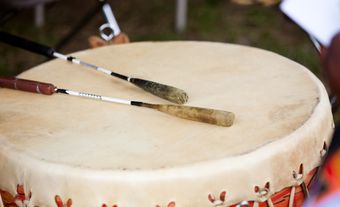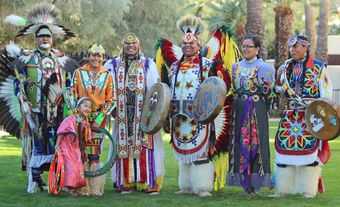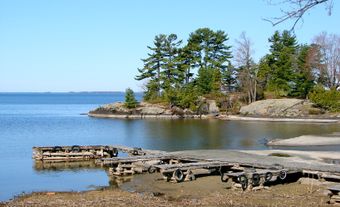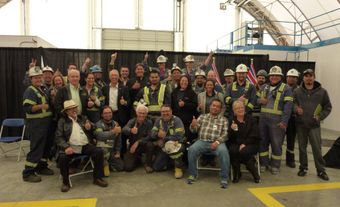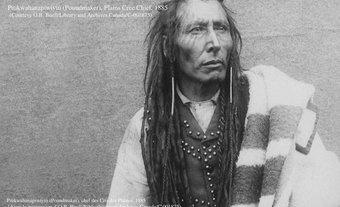First Nation is one of three groupings of Indigenous people in Canada, the other two being Métis and Inuit. Unlike Métis and Inuit, most First Nations hold reserve lands. Members of a First Nation may live both on and off these reserves. While the term First Nation can describe a large ethnic grouping (e.g. the Cree Nation), in other cases it is synonymous with the term band. The term band was originally chosen by the federal government and used in the Indian Act. The word band describes smaller communities. Many First Nations prefer the term First Nation over band.
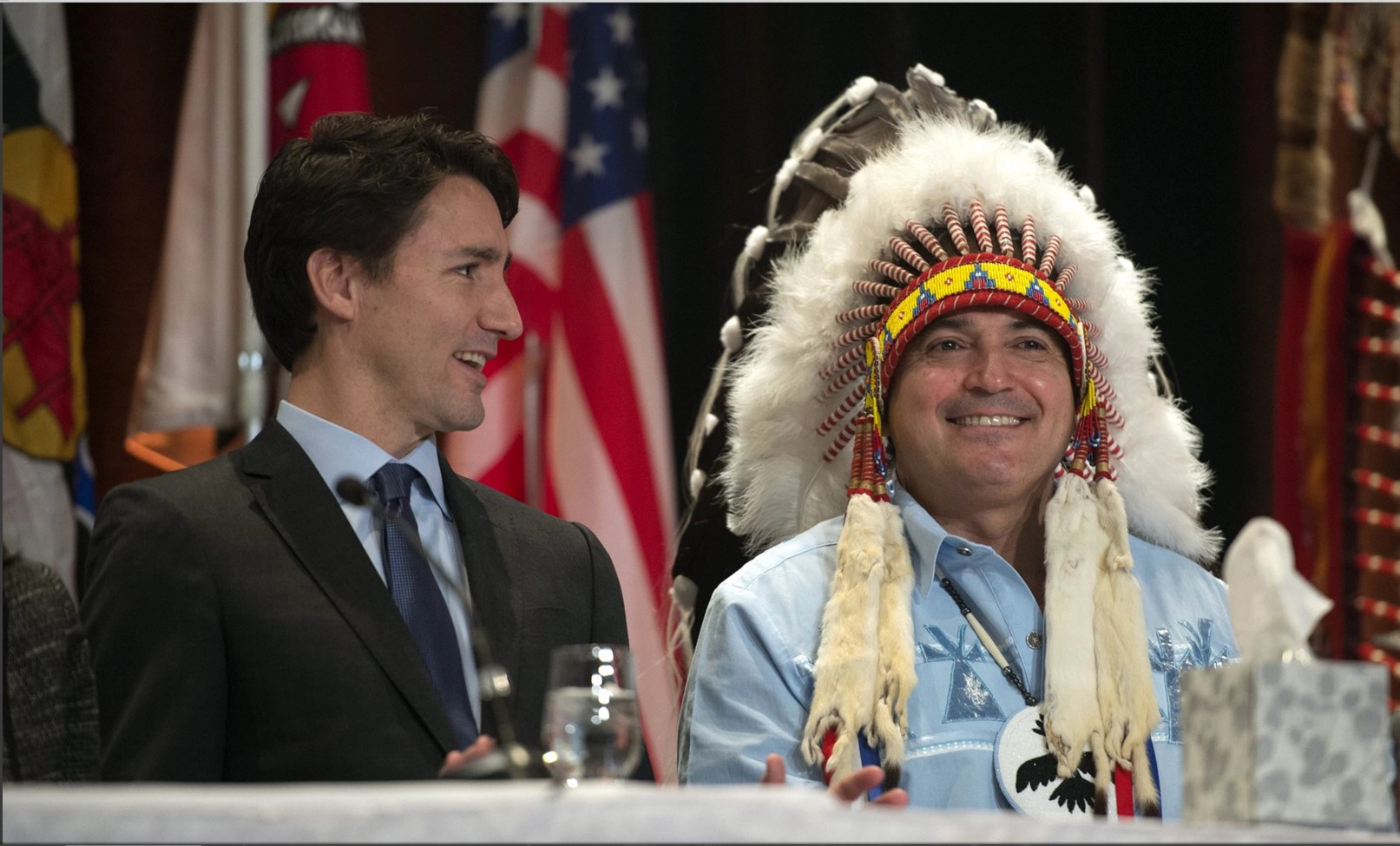
List of First Nations
For more detailed information about First Nations in Canada’s provinces and territories, please see:
- First Nations in British Columbia
- First Nations in Alberta
- First Nations in Saskatchewan
- First Nations in Manitoba
- First Nations in Ontario
- First Nations in Quebec
- First Nations on Prince Edward Island
- First Nations in New Brunswick
- First Nations in Newfoundland and Labrador
- First Nations in Nova Scotia
- First Nations in the Northwest Territories
- First Nations in Yukon
- Nunavut is the homeland of the Inuit. While non-Inuit live in Nunavut, there are no First Nations in that territory.
Terminology
First Nations is a term used to describe Indigenous peoples in Canada who are distinct from Métis or Inuit.
Section 35 of the Constitution Act of 1982 declares that Aboriginal peoples (the legal term used for Indigenous peoples) in Canada include Indian (First Nations), Inuit and Métis peoples. First Nations people are sometimes known by other names, like Indians, Natives or Amerindians. These names may be problematic, as some have negative connotations. However, in Canada, the term Indian has specific legal contexts. The document governing the federal government’s relationship with First Nations people is called the Indian Act. As part of the Indian Act, the federal government maintains an Indian Register that is an official record of all First Nations people who are recognized as Status Indians.
Before the 1980s, the most popular term for a person of First Nations heritage in Canada was Indian. In 1980, hundreds of chiefs met in Ottawa and used First Nations for the first time in their Declaration of the First Nations. In 1982, the National Indian Brotherhood became the Assembly of First Nations. They are a political voice for First Nations people in Canada. Symbolically, the term elevates First Nations to the status of "first among equals" as founding nations of Canada. It is reflective of the sovereign nature of many communities and the ongoing quest for self-determination and self-government. The term is not used by Indigenous peoples outside Canada.
First Nations should be used exclusively as a general term. Community members are more likely to define themselves as members of specific nations or communities within those nations. For example, a Kanyen’kehà:ka (Mohawk) person from Akwesasne who is a member of the Bear clan may choose any number of identifiers. These chosen identifiers would all be more accurate than “First Nations person” or “Indigenous person.”
Take the quiz!
Test your knowledge of Indigenous peoples by taking this quiz, offered by the Citizenship Challenge! A program of Historica Canada, the Citizenship Challenge invites Canadians to test their national knowledge by taking a mock citizenship exam, as well as other themed quizzes.
History
Indigenous peoples have been in Canada since time immemorial. They formed complex social, political, economic and cultural systems.
With colonization and white settlement, traditional Indigenous ways of life were forever altered. Colonial practices and policies sought to control and assimilate Indigenous peoples. These include the Indian Act, pass system, reserves and residential schools. Combined with racism, segregation and loss of land, these practices and policies have negatively impacted Indigenous peoples in profound ways, including in terms of their health and socio-economic well-being. (See also Social Conditions of Indigenous Peoples and Economic Conditions of Indigenous Peoples).
The final reports of the Truth and Reconciliation Commission and the National Inquiry into Missing and Murdered Indigenous Women and Girls speak to the ongoing work of reconciliation (see Reconciliation in Canada).
Treaties
Many First Nations have signed treaties with the Crown. Treaties form the constitutional and moral basis of alliance between Indigenous peoples and Canada. While Métis and Inuit have distinct agreements with the federal government, historic treaties were signed almost exclusively with First Nations.
Treaties differ based upon the timeframe in which they were created and the reasons for their completion. Generally, these agreements allowed for the use of Indigenous lands by non-Indigenous peoples in exchange for annual payments, guaranteed rights and other benefits. Examples of treaties that cover large areas of land in Canada include the Peace and Friendship Treaties in the Maritime provinces and Gaspé region. The purpose of these treaties was to bring peace and trade relations. The federal government signed Numbered Treaties in the Prairies, Northwestern Ontario, the Northwest Territories and portions of the Yukon and British Columbia. The government wanted the Numbered Treaties to allow settlement in the west and gain Indigenous lands. First Nations who signed the Numbered Treaties were made promises, both orally and in writing, that were meant to protect their inherent rights and support them in the changing economy. (See also Treaties with Indigenous Peoples in Canada.)
Population and Communities
First Nations people may live on or off reserve. Also, they may or may not have legal status under the Indian Act. Even if they have legal status, they may or may not be registered members of a band or nation. Communities may be large or small, relatively urban or extremely remote and exist throughout Canada. Only the Gwich’in and Sahtu extend north of the Arctic Circle.
According to the 2021 census by Statistics Canada, 1,048,405 people in Canada identified as being First Nations. There are 630 First Nations communities in Canada, speaking more than 50 distinct languages.
Socio-Economic Conditions
Socio-economic conditions contribute to the well-being of all people. These include health, income, education, employment and community. Among First Nations peoples (as well as Indigenous peoples, in general), socio-economic conditions have been impacted by the dispossession of cultural traditions, social inequities, prejudice and discrimination. Progress has been made towards better socio-economic conditions. However, there are still gaps between the socio-economic conditions of Indigenous and non-Indigenous people in Canada.
In July 2019, a report co-authored by the Assembly of First Nations (AFN) and the Canadian Centre for Policy Alternatives revealed that 47 per cent of the 254,100 status First Nations children in Canada live in poverty. Nationally, status First Nations children are nearly four times more likely to live in poverty than non-Indigenous, non-racialized children. The authors of the report tracked child poverty using Statistics Canada’s 2006 Census, 2011 National Household Survey and 2016 Census. The study revealed differences in the poverty rate for status First Nations children living on-reserve (53 per cent) and those living off-reserve (41 per cent). (See also Reserves.)
Poverty rates were highest on the Prairies. Status First Nations children in Manitoba and Saskatchewan living on reserves faced extreme poverty rates of 65 per cent. In comparison, recent studies reveal that non-Indigenous children in Manitoba have a poverty rate of 15 per cent. In Saskatchewan, these same children face a poverty rate of 16 per cent. In Quebec, the poverty rate for First Nations children living on reserves was lower at 29 per cent. This is most likely due to agreements between First Nations and the province to share natural resource revenues. In particular, these include Hydro-Québec revenues. The national poverty rate for the 4.5 million non-Indigenous, non-racialized children is 12 per cent.
Perry Bellegarde, who was the National Chief of the AFN at the time of the report, declared that “The findings of this report are shameful and underscore the urgent need to invest in First Nations children, families and communities. Our children face the worst social and economic conditions in the country.… It’s beneficial to all Canadians to close the gap in quality of life between First Nations and Canada.” The AFN and authors of Towards Justice believe that a “national poverty strategy” should be implemented immediately. It would tackle and reduce child poverty among Indigenous children. This plan would include self-determination for Indigenous peoples, increased government funding and resource revenue sharing arrangements between Indigenous peoples and government.
The 2021 Census revealed that nearly one in five Indigenous people in Canada live in a low-income household. This is less than in the 2016 Census. However, Statistics Canada argues the decline was likely the result of government transfers during the COVID-19 pandemic.

 Share on Facebook
Share on Facebook Share on X
Share on X Share by Email
Share by Email Share on Google Classroom
Share on Google Classroom

